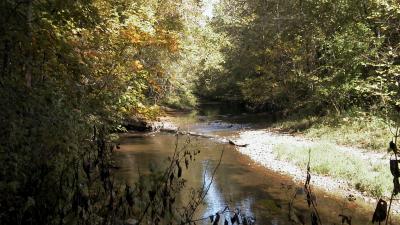Marott Woods Nature Preserve overview
Marott Woods Nature Preserve is located in north-central Indianapolis. The main entrance is located on College Avenue just across from Park Tudor School. The nature preserve is composed of an old second-growth mixed mesophytic upland forest in the north, and floodplain forest and successional fields along Williams Creek and the White River to the south. Tree species throughout the nature preserve include Ohio buckeye, paw paw, bur and chinquapin oaks, and rough-leaved dogwood.
Service learning students have been working in this area with Indy Parks and Recreation since 1996. Service-learning projects contribute to the ongoing restoration of the area and include removal of invasive exotic plant species, erosion control, hill slope stabilization, and hardwood forest restoration.
Background information
Marott Woods Nature Preserve is named after the Marott family (George and Ella) who donated ~ 87 acres of land to be used as a nature park. Later, other parcels were donated for a total of ~102 acres of parkland. The area is a dedicated Indiana nature preserve owned by the city of Indianapolis and managed by the Office of Land Stewardship (Indy Parks) in coordination with the Indiana Department of Natural Resources, Division of Nature Preserves (IDNR-NP). The first portion of the preserve dedicated in 1987 is a second growth 16-acre forested natural area. This part of the nature preserve is considered one of the best areas in Marion County for viewing wildflowers and native flora. This natural remnant allows the park visitor to see an example of how the county may have looked prior to settlement in the 1820’s. In 1992, much of the remainder of the park was added as a nature preserve. It is this latter addition that requires intensive management. Agriculture and other past land use has propagated a weedy landscape that does not provide quality of habitat or the environmental benefits of a natural area. The long-range goal is to convert the weedy portion of the preserve to native floodplain woodland.
Project site
The site contains 22 acres of old field in early woodland succession. By looking at aerial photographs from 1937, 1941, and 1956 and into the late seventies, this area was used for row crop agriculture. The agricultural field lay fallow and the property is now in an early woodland stage of succession. Plant species such as staghorn sumac and Canada goldenrod grow here. Native trees include young stands of mesic floodplain tree species such as sycamore and hackberry. However, most of the area contains thick pockets of invasive exotic shrubs and trees. The most common species is Amur honeysuckle. Other species include Siberian elm, white mulberry, tree-of-heaven, and common privet. There are also several invasive groundcovers and vines; these include wintercreeper, Japanese honeysuckle, oriental bittersweet, crown vetch, and vinca. Garlic mustard is also prominent.
Project goals
The short-term goal is to establish control over the invasive plants and the seeds that will vigorously sprout from the seed bank in the soil. The long-term goal of the restoration is to sustain the recovery and regeneration of native forest plant communities that include native canopy trees, understory shrubs and trees, and an herbaceous layer of flowers, grasses and sedges.
Control methods
Control of dense stands of invasive plants involves intensive management. Heavy equipment is often needed, including a chippers, trucks, and tractors. Control and removal methods in the old agricultural field in the east and northeast portions of Marott required a phased approach to achieve the management objectives. Natural succession processes resulted in a tangled stand of almost impenetrable exotic shrubs, trees and vines. Mixed within dense stands of invasive plants are native “pioneer plants” such as box elder, ash and cottonwood. In this situation, most invasive shrubs and trees were chipped and hauled offsite. Native woody species were thinned to optimize growth rates while allowing access and maneuverability for maintenance and planting equipment. Groups of native plants, such as cottonwood or sumac stands, that were relatively unspoiled by invasive plants were maintained. The short-term goal in the old agricultural field area was to remove a majority of invasive shrubs and establish native canopy trees and a native grass layer. Natural succession was interrupted for a period of time until exotic seed sources and plants were controlled. Gradually, pockets of native vegetation were reintroduced and natural succession was allowed to continue as native plants regained dominance. Monitoring and follow-up walkthrough maintenance continues annually. Native plants were reintroduced to fill the niche that wintercreeper and other exotics previously controlled. The other goal of native plant introduction is to establish an appropriate seed source to enhance regeneration in areas that have significant loss of one or more components of forest structure.
A number of Eagle Scout candidates, churches and businesses have donated their time to restoring this area. Additionally, the Center for Earth and Environmental Science, the Sierra Club and Butler University Department of Biological Sciences are partner groups that help maintain the preserve.



